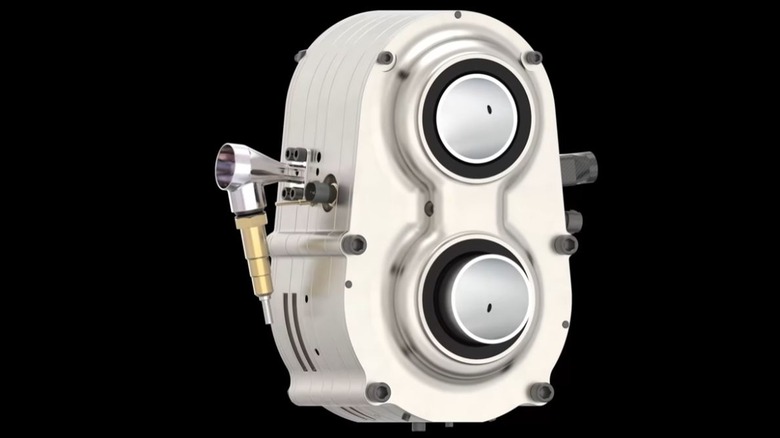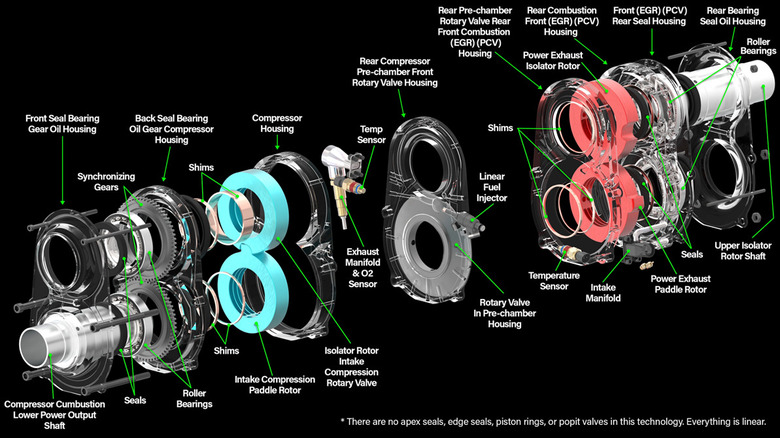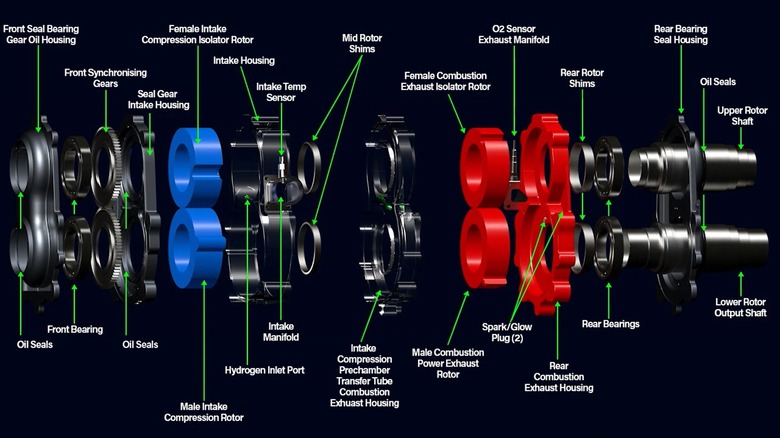Is Astron's Omega 1 Engine Real? Here's Everything You Need To Know
As demands for sustainability ramp up, electric vehicle systems have become one of the major focuses of the engineering scene, with certain governments even hoping to gradually phase out traditional combustion engines over the next decade. Because of this, the idea of pursuing new combustion engine designs may seem like a waste of time. However, just because electric engines make up the most obvious path toward sustainability, that doesn't mean it's the only path.
Engineering company Astron Aerospace has been hammering out new ideas for a different kind of sustainable engine, a rotary engine designed not only to cut emissions down to nearly nothing, but receive the much more renewable power of hydrogen fuel instead of traditional petroleum. The engine in question is called the Omega 1, and while it may not look like the kind of engine you're used to, this conceptual beast might just revolutionize the automotive field one day.
How the Omega 1 engine works
The Omega 1 engine is what's known as a rotary engine, a concept that actually dates all the way back to the 1950s. Rotary engines were conceptualized by German engineer Felix Wankel as an alternative to the piston-powered combustion engines we know today. The idea is to use a single spinning rotor to compress fuel and generate power instead of a set of pistons, which, ideally, would have better fuel efficiency, reduced knocking, and a lighter composition. Multiple automotive manufacturers over the decades have tried to make this concept work, but it never quite took off the way piston-powered engines did.
The Omega 1 differentiates itself from these older designs with two rotors instead of just one. These rotors are made up of two large, interlocking gears, one with a distinctive groove and the other with a large paddle designed to link up as they pass each other by. As this occurs, air and fuel are injected into the chamber and pass a small ignition point. This creates the little explosion you'd expect from a combustion engine, propelling the gears around again for another go. The rotational power generated by the gears is transferred to the rotors, which in turn generate the power necessary to propel a vehicle forward.
How this system improves on combustion engines
The way the Omega 1 generates power is vastly more efficient than your average combustion engine. For one thing, due to the linear, flush design of the gears and grooves, the Omega 1 experiences far less power loss than the piston casings in a typical engine. Piston-powered engines can occasionally lose heat to friction, which can then waste fuel as it tries to compensate. Since the design is nice and tight, not to mention air-cooled, there's no power loss.
Additionally, the power output of this engine is remarkable in proportion to its size. According to Astron's statistics, a single Omega 1 engine can generate around 160 horsepower despite weighing only 35 pounds. If your car were equipped with an engine like this, it could go much faster without the weight of a massive engine tying it down. Not only that, but you can stack multiple Omega 1s together to compound their speed while still weighing relatively little.
Perhaps the most attractive aspect of the Omega 1 is its emissions, or rather, lack thereof. The majority of the emissions produced by the Omega 1 is harmless water vapor, and while there may be some hazardous emissions like nitrogen oxide, the amount produced would be exponentially less than an average combustion engine. Astron has also noted, should it be made available, the Omega 1 could receive hydrogen fuels, which would eliminate those harmful emissions entirely.
Does it actually exist?
The answer to whether or not Astron's Omega 1 engine is real more or less depends on what you mean by "real." Is it a real, tangible engine that you can buy now and install on your car? No, it is not real in that sense. Astron has not sold the Omega 1 engine or implemented it into other systems at the time of writing, nor can you obtain one through other means to install it on your vehicle. The mere notion of hydrogen-powered rotary engines is still deep in testing and isn't ready for prime time.
However, the Omega 1 engine is "real" in that it's a patented concept owned by Astron and in active research. The Omega 1 is the precursor to Astron's current focus of development, the H2 Starfire system, a similarly-designed rotary engine that takes multiple cues from the Omega 1's development and simplifies the concept even further. If and when Astron's research and development process yields a tangible engine that you can install on a vehicle, it might not be called the Omega 1, but it will likely function in the same way, more or less.


